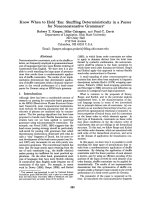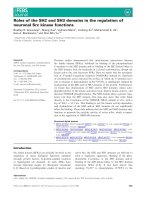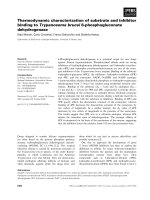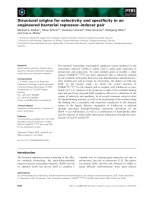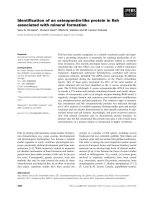Báo cáo khoa hoc:" TOPBP1 missense variant Arg309Cys and breast cancer in a German hospital-based case-control study" pot
Bạn đang xem bản rút gọn của tài liệu. Xem và tải ngay bản đầy đủ của tài liệu tại đây (288.28 KB, 4 trang )
BRIE F REP O R T Open Access
TOPBP1 missense variant Arg309Cys and breast
cancer in a German hospital-based case-control
study
Magda A Blaut
1
, Natalia V Bogdanova
1,2
, Michael Bremer
2
, Johann H Karstens
2
, Peter Hillemanns
1
, Thilo Dörk
1*
Abstract
The DNA double strand break repair gene TOPBP1 has been suggested as a breast cancer susceptibility gene and a
missense variant Arg309Cys was observed at elevated frequency in familial breast cancer cases compared to
healthy controls from Finland. We found the Arg309Cys allele at a 13% carrier frequ ency in a hospital-based series
of 1064 German breast cancer patients and at a 14% carrier frequency in 1014 pop ulation controls (OR 0.89, 95%CI
0.69-1.15; p = 0.4). Arg309Cys carriers were not enriched among patients with a family history of breast cancer (OR
= 0.87, 95%CI 0.53-1.43, p = 0.6) and were slightly underrepresented in patients with bilateral disease (OR = 0.49,
95%CI = 0.24-0.99; p = 0.047). In the latter group , the mean age at diagnosis was 62 years in carriers and 54 years
in non-carriers (p = 0.004). We conclude that there is no evidence for the TOPBP1*Arg309Cys variant to con fer an
increased risk for breast cancer in the German population.
Findings
Only a small proportion of breast cancer cases can be
attributed to mutations in high-penetrance genes such
as BRCA1 or BRCA2, and much of the remaining case s
are a ttributed to more common gene variants with
lower penetran ce [1,2]. As many of t he hitherto known
susceptibility factors have been implicated in the cellular
responses to DNA double-strand breaks and replication
stress, there is considerable interest in genetic variants
of additional proteins involved in these pathways [2].
TOPBP1 encodes a protein that shares homology to
BRCA1, is aberrantly expressed in breast carcinomas
and has a critical role in DNA damage and replication
checkpoint pathways [3-7]. TOPBP1 encodes a 1522
amino acid BRCT domain protein that interacts with
DNA topoisomerase IIb andisinvolvedinATM/ATR-
mediated DNA damage and replication checkpoint path-
ways [3-6]. Reduced or aberrantly localized TopBP1
expressi on has been observed i n a si gnificant proportion
of breast cancer specimens [7]. Functional TOPBP1
variants therefore represent plausible candidate breast
cancer susceptibility alleles. A recent sequencing and
case-control association study has assessed the role of
germ-line variants in F innish breast and o varian cancer
patients [8]. The novel Arg309Cys substitution was
observed at significantly higher frequency in 125 familial
breast and/or ovarian cancer patients compared to 697
healthy controls (15.2% versus 7.0%; P = 0.002), and a
2.4-fold increase i n risk was suggested [8]. We aimed to
corroborate this finding in a hospital-based series of
1064 German breast cancer patients and 1014 popula-
tion controls.
Our German study population consisted of a hospital-
based series of 1012 unselected breast canc er patients
who were treated at the Dep artment of Radiation
Oncology at Hannover Medical School from 1996-1999
and an additional small series of 52 patients with bilat-
eral breast cancer collected later from the same hospital.
Median age at onset of breast cancer was 57 years in
this patient group, and 144 patients (13.5%) reported at
least one first-degree relative with breast cancer. The
series had been used previously to determine the fre-
quency of mutations in the BRCA1, ATM, NBS1 and
CHEK2 genesaswellastocharacterizemorecommon
polymorphisms studied by the Breast Cancer Associa-
tion Consortium. The population controls were 1014
anonymous female German volunteers who had been
ascertained between August and December 2005 at
* Correspondence:
1
Clinics of Obstetrics and Gynaecology, Hannover Medical School, Carl-
Neuberg-Str. 1, D-30625 Hannover, Germany
Full list of author information is available at the end of the article
Blaut et al. Journal of Negative Results in BioMedicine 2010, 9:9
/>© 2010 Blaut et al; licensee BioMed Central Ltd. This is an Open Access article distributed under the terms of the Creative Commons
Attribution License (h ttp://creativecommons.org/licenses/by/2.0), which permits unrestricted use, distribution, and reproduction in
any medium, provided the original w ork is properly cited.
Hannover Medical School, Lower Saxony, Germany.
Written informed consent had been obtained from all
patients, and the study was approved by the local Ethics
Commission.
Genomic DNA was isolated from peripheral white
blood cells using a routine protocol employing protei-
nase K digestion and phenol-chloroform extraction. A
region spanning the exon 8 was amplified by PCR with
the primers 5’ -AGATTTCAGTAAACACCCCTG-3’
(forward) and 5’ -GGTCTTCAAAGTCAGGCTAG-3’
(reverse) using HotStart Taq DNA Polymerase ( Qiagen)
and 35 cycles of 1 min denaturation at 94°C, 1 min
annealing at 60°C and 1 min extension at 72°C. 168
samples were initially evaluated by restriction-enzyme
based analysis to identify heterozygous and homozygous
carriers. For this purpose, PCR products were incubated
with Tat I (Fermentas) and anal ysed on a 2% agarose gel.
We further established a 5’ -nuclease assay for the discri-
mination of the A rg and Cys alleles using specif ic FAM-
or VIC-labelled MGB probes (Applied Biosystems). The
probe seq uences were 5’-VIC- TGAAAGAGTACGACC-
TACA- MGB- 3’ and 5’-FAM- TGAAAGAGTACAACC-
TACA- MGB- 3’ , respectively. 60 PCR cycles with an
annealing step at 6 0°C were performed in 96-well-plates
onaFAST7500SequenceDetectionSystem(Applied
Biosystems), and genotypes were determined from the
fluorescence emission in each well using the FAST 7500
Sequence Detection System software. The call rate was
98.8% in the breast cancer samples and 99.9% in the con-
trol series.
To furthe r validate the results of mutation screening,
all homozygotes and selected heterozygous samples
were confirmed by direct sequencing using a BigDye
Terminator protocol and capillary gel electrophoresi s on
an Avant 3100 Sequence Analyser (Applied Biosystems).
Results from direct sequencing, restriction enzyme ana-
lysis and from the 5’nuclease assay were concordant in
all samples.
Genotype distributions were compared between cases
and controls, or between different patient subgroups,
and odds ratios were determined under dominant, co-
dom inant and recessive models using the SNP & Vari a-
tion Suite 7. 0 software (Golden Helix Inc.). Results were
considered non-significant for p-values > 0.05 (2 df).
Ages at diagnosis were comparedusingaT-test(Mini-
tab 15) and a median test (Statistix 7.0).
We confirmed the Arg30 9Cys missense substitution in
an initial sample by restriction enzyme analysis and
direct sequencing, and then employed a 5’-nuclease
assay for the discrimination of the Arg and Cys alleles
in genomic DNA samples from all the HaBCS case-con-
trol series (Figure 1). Variant genotype data were
Figure 1 Detection and screening of the TOPBP1*Arg309Cys
substitution by (a) direct sequencing, (b) restriction enzyme
analysis, and (c) 5’-nuclease allelic discrimination assay.a)
Direct sequencing of the sense strand of TOPBP1 exon 8. From top
to bottom: Homozygous genotype Arg/Arg, heterozygosity Arg/Cys,
homozygous genotype Cys/Cys. The position of the mutation is
marked by an asterisk. b) Restriction enzyme analysis after
incubation with Tat I and 2% agarose gel electrophoresis. Lanes
from left to right: common homozygote (Arg/Arg, 1-1),
heterozygous sample (Arg/Cys, 1-2), rare homozygote (Cys/Cys, 2-2).
c) 5’-nuclease allelic discrimination assay identifying common
homozygotes (Arg/Arg, red circles), heterozygotes (Arg/Cys, green
triangles), and rare homozygotes (Cys/Cys, blue square). NTC, no
template control.
Table 1 Arg309Cys genotype distribution in German breast cancer cases and controls
TOPBP1 Genotype OR (95% CI) (any Cys vs. Arg/Arg) p
Arg/Arg Arg/Cys Cys/Cys
Population controls (n = 1014) 879 (.87) 130 (.13) 5 (.005)
Breast cancer (n = 1064) 936 (.88) 123 (.12) 5 (.005) 0.89 (0.69-1.15) 0.39
- familial 150 (.88) 19 (.11) 1 (.01) 0.87 (0.53-1.43) 0.56
- bilateral 118 (.93) 9 (.07) 0 0.49 (0.24- 0.99) 0.047
- age < 50 ys 263 (.89) 31 (.10) 2 (.01) 0.82 (0.55-1.22) 0.37
- ductal 606 (.90) 69 (.10) 2 (.003) 0.76 (0.56-1.04) 0.09
- node positive 270 (.88) 36 (.12) 1 (.01) 0.89 (0.61-1.32) 0.63
- ER negative 72 (.87) 10 (.12) 1 (.01) 0.99 (0.51-1.92) 1
Relative distribution of TOPBP1 cod on 309 genotypes in cases and controls shown as number of carriers and, in brackets, as relative fraction. Odds ratios are
calculated for carriers of the rare Cys309 allele (with homozygous and heterozygotes combined) versus common homozygotes. P values were calculated using
Fisher’s exact test.
Blaut et al. Journal of Negative Results in BioMedicine 2010, 9:9
/>Page 2 of 4
obtained for all 1064 patient s (1050 with invasive breast
cancer, and 14 with in situ carcin oma) and 1014 female
population controls. We did not detect significant differ-
ences neither in the allelic nor in the genotypic distribu-
tion of the Arg309Cys variant between the case and
control series under any of the three models applied.
Results obtained under a dominant model, with hetero-
zygous and homozygous carriers combined, are pre-
sented in Table 1. When stratified by clinical
parameters, the most suggestive trend was a slightly
lower frequ ency of the variant in patients with bilate ral
disease compared with controls (OR = 0.49, 95%CI =
0.24-0.99; p = 0.047) (Table 1), contrary to the expected
increase in risk for variant carriers. Furthermore, the
mean age at diagnosis of the first cancer among patients
with bilater al disease was 62.3 years in carriers and 53.8
years in non-carriers (p = 0.004) (Figure 2). Median age
at diagnosis was also higher in the carrier group (p =
0.02). Among patients with bilateral disease, Arg3 09Cys
carriers were underrepresented among patients with
nodal metasta sis compared with non-carriers (p = 0.01).
Carriership also tended to oc cur at a non-significantly
lower frequency in the major group of ductal invasive
cancers (OR 0.76, 95% CI 0.56-1.04, p = 0.09). No differ-
ences between carriers and non-carriers were observed
in the total series with respec t to age at diagnosis, hor-
mone receptor or nodal status.
Our data indicate that the Arg309Cys substitution
occurs at a similar frequency in German individuals as
reported in the previous study [8], indicating that its
distribution is not confined to the Finnish population.
However, we could not confirm the hypothesis that it
constitutes a significant risk factor for breast cancer,
and the upper limit of our 95%CI is not included within
the l imits proposed in the Finnish Study (95%CI 1.3-4.2,
Ref. [8]). Our study had some 80% power to detect a
1.4-fold difference, thus minor r isks cannot be formally
exclud ed. An important difference between the study by
Karppinen et al. [8] and ours is that the former focussed
on familial breast cancer whereas we analysed a hospi-
tal-based series unselected for family history. On the
other hand, no trend became ap parent when the patient
subgroup with a first-degree family history of breast
cancer in our series was analysed separately. An addi-
tional indicator for a genetic predisposition is bilateral
disease [9]. However, our results showed that the
Arg309Cys variant was rather underrepresented in cases
with bilateral breast cancer compared to healthy con-
trols, and we furthermore observed significa nt differ-
ences between carriers and non-carriers with respect to
the age at diagnosis which ma y suggest a protective role
for the Cys allele.
Altogether, we find no general association of the
TOPBP 1 Arg309Cys variant with breast cancer risk, and
the direction of the marginally significant association
with bilateral disease in our study is in conflict with the
original data. Our results thus do not support the
increased ri sk for A rg309Cys, though it cannot be ruled
out that TOPBP1 variants exist which may confer an
increased susceptibility towards breast cancer. In the
initial report, however, the Arg309Cys substitution was
among five different coding variants the only one that
appeared associat ed with breast cancer. From our
results, there is no evidence to conclude that the
Arg309Cys substitution is a strong cancer susceptibility
allele. Further research may reveal whether any TOPBP1
gene variants can contribute to hereditary breast cancer
risk.
Abbreviations
SNP: single nucleotide polymorphism; BRCT: breast cancer 1
carboxyterminal; PCR: polymerase chain reaction; MGB : minor groove
binding.
Author details
1
Clinics of Obstetrics and Gynaecology, Hannover Medical School, Carl-
Neuberg-Str. 1, D-30625 Hannover, Germany.
2
Clinics of Radiation Oncology,
Hannover Medical School, Carl-Neuberg-Str. 1, D-30625 Hannover, Germany.
Authors’ contributions
MAB carried out the molecular genetic studies, performed the statistical
analysis and helped to draft the manuscript. NVB helped to carry out the
molecular genetic studies and participated in the design of the study. MB,
JHK, and PH participated in its design and coordination and helped in the
acquisition of clinical data. TD initiated the study, participated in the analysis
and interpretation of data, and drafted the manuscript. All authors read and
approved the final manuscript.
Competing interests
The authors declare that they have no competing interests.
Received: 16 September 2010 Accepted: 25 November 2010
Published: 25 November 2010
Figure 2 Mean age at diagnosis of the first primary in patients
with bilateral breast cancer stratified by TOPBP1 codon 309
genotypes. The mean is indicated by a black diamond, and 95%
confidence intervals are shown.
Blaut et al. Journal of Negative Results in BioMedicine 2010, 9:9
/>Page 3 of 4
References
1. Pharoah PD, Antoniou A, Bobrow M, Zimmern RL, Easton DF, Ponder BA:
Polygenic susceptibility to breast cancer and implications for prevention.
Nat Genet 2002, 31:33-36.
2. Walsh T, King MC: Ten genes for inherited breast cancer. Cancer Cell 2007,
11:103-105.
3. Mäkiniemi M, Hillukkala T, Tuusa J, Reini K, Vaara M, Huang D, Pospiech H,
Majuri I, Westerling T, Mäkelä TP, Syväoja JE: BRCT domain containing
protein TopBP1 functions in DNA replication and damage response. J
Biol Chem 2001, 276:30399-30406.
4. Garcia V, Furuya K, Carr AM: Identification and functional analysis of
TopBP1 and its homologs. DNA Repair 2005, 4:1227-1239.
5. Kumagai A, Lee J, Yoo HY, Dunphy WG: TopBP1 activates the ATR-ATRIP
complex. Cell 2006, 124:943-955.
6. Delacroix S, Wagner JM, Kobayashi M, Yamamoto K, Karnitz LM: The Rad9-
Hus1-Rad1 (9-1-1) clamp activates checkpoint signalling via TopBP1.
Genes Dev 2007, 21:1472-1477.
7. Going JJ, Nixon C, Dornan ES, Boner W, Donaldson MM, Morgan IM:
Aberrant expression of TopBP1 in breast cancer. Histopathology 2007,
50:418-424.
8. Karppinen SM, Erkko H, Reinib K, et al: Identification of a common
polymorphism in the TopBP1 gene associated with hereditary
susceptibility to breast and ovarian cancer. Eur J Cancer 2006,
42:2647-2652.
9. Antoniou AC, Easton DF: Polygenic inheritance of breast cancer:
Implications for design of association studies. Genet Epidemiol 2003,
25:190-202.
doi:10.1186/1477-5751-9-9
Cite this article as: Blaut et al.: TOPBP1 missense variant Arg309Cys and
breast cancer in a German hospital-based case-control study. Journal of
Negative Results in BioMedicine 2010 9:9.
Submit your next manuscript to BioMed Central
and take full advantage of:
• Convenient online submission
• Thorough peer review
• No space constraints or color figure charges
• Immediate publication on acceptance
• Inclusion in PubMed, CAS, Scopus and Google Scholar
• Research which is freely available for redistribution
Submit your manuscript at
www.biomedcentral.com/submit
Blaut et al. Journal of Negative Results in BioMedicine 2010, 9:9
/>Page 4 of 4



